Abstract
1. A technique for the spectrofluorometric analysis of 5-hydroxytryptamine, histamine, noradrenaline and dopamine in a single lung sample has been developed. The method is a combination of the extraction procedure of Shore & Olin (1958), plus the modification introduced by Hogans (1967) for the analysis of three of the four amines. The fourth amine, histamine, was analysed by the method of Shore, Burkhalter & Cohn (1959), which was combined with the analysis of the other three amines. The combined procedure consisted principally of disintegrating the lung tissue in butanol and subsequent separation of amines for measurement of fluorescence, either directly, as for 5-hydroxytryptamine, or after formation of fluorophores, as for histamine, noradrenaline and dopamine. It has been possible to analyse all four amines from a sample of the lung in which the bronchopulmonary responses have been investigated.
2. The concentration of 5-hydroxytryptamine in the lung of seven species ranges from about 0·5 μg/g in the guinea-pig, dog and man to about 7 μg/g in the rabbit. The pulmonary resistance is increased after an injection of 5-hydroxytryptamine in the rat and guinea-pig.
3. The guinea-pig is more sensitive to 5-hydroxytryptamine than the rat. In both animal species, the content of 5-hydroxytryptamine in the lung is elevated by administration of either 5-hydroxytryptamine or 5-hydroxytryptophan. In the rat, the administration of p-chlorophenylalanine reduces the content of 5-hydroxytryptamine in the brain but not in the lung.
4. It is suggested that the 5-hydroxytryptamine contained in the lung tissue is stored mainly in the platelets and in the mast cells.
Full text
PDF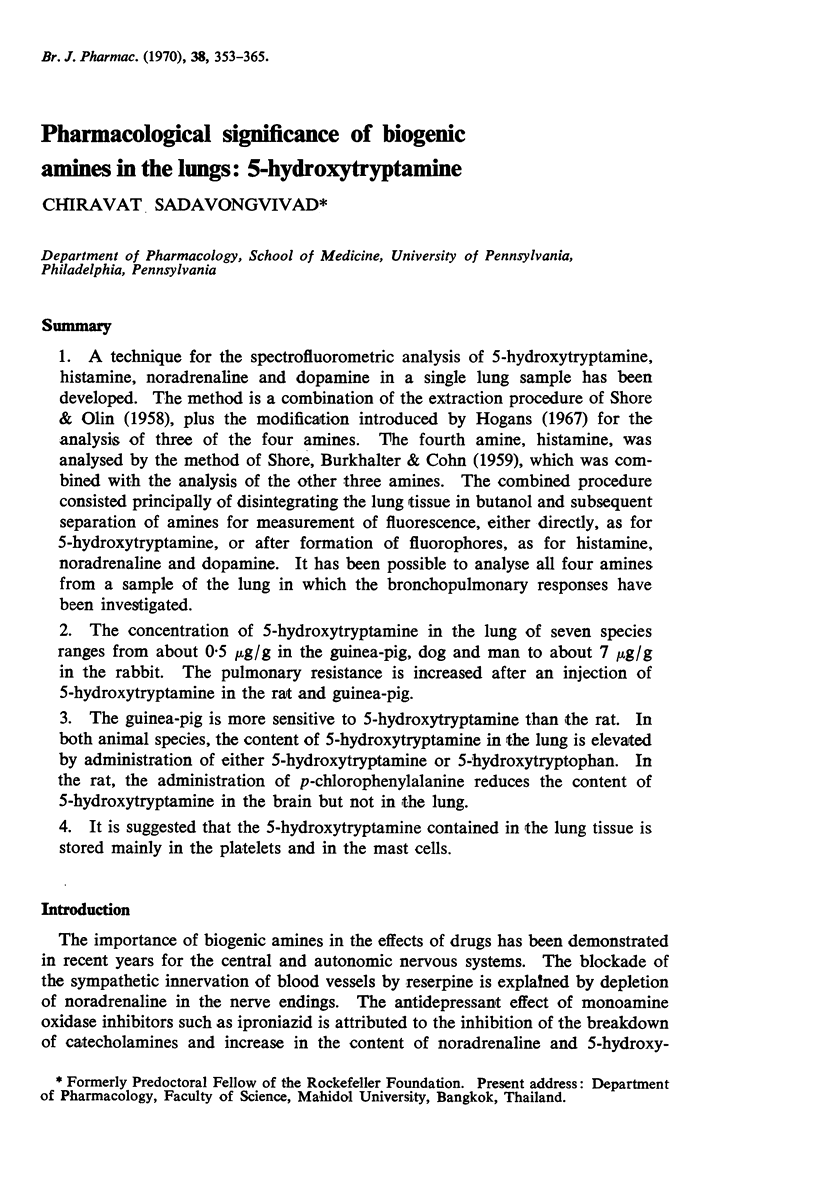

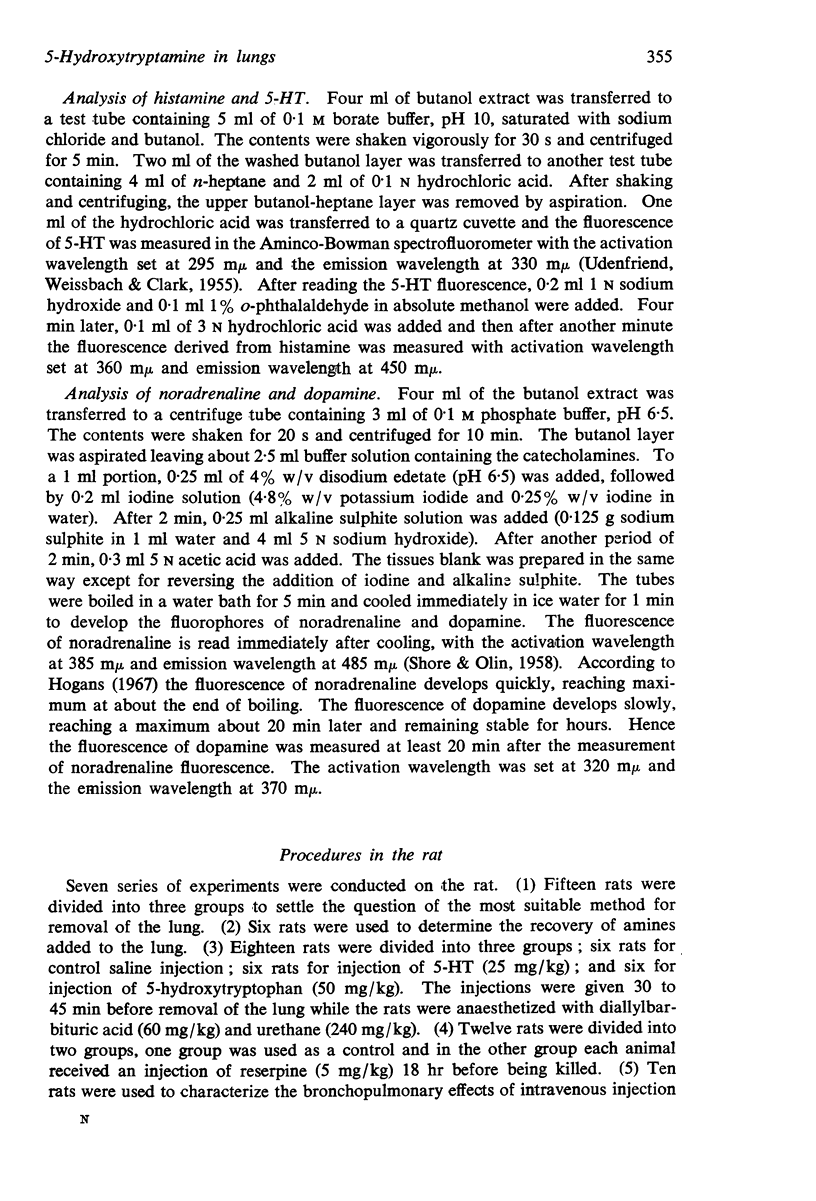
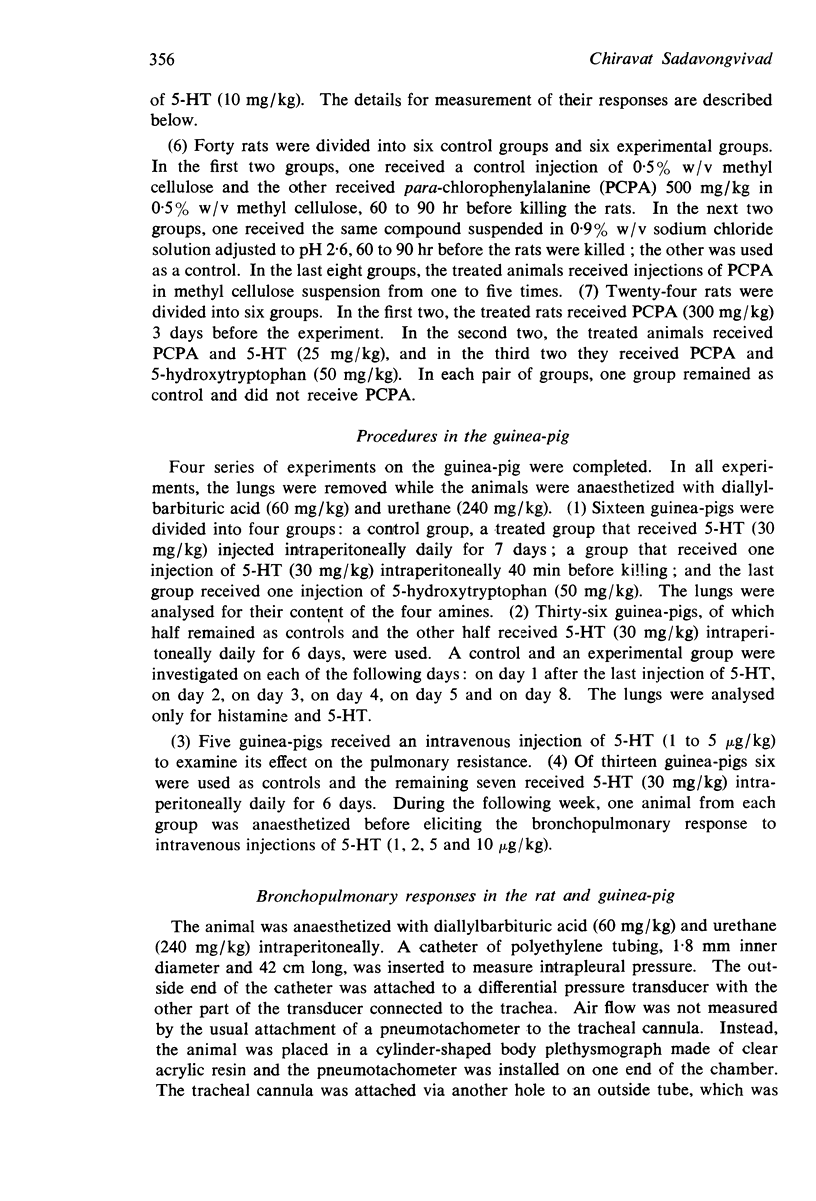
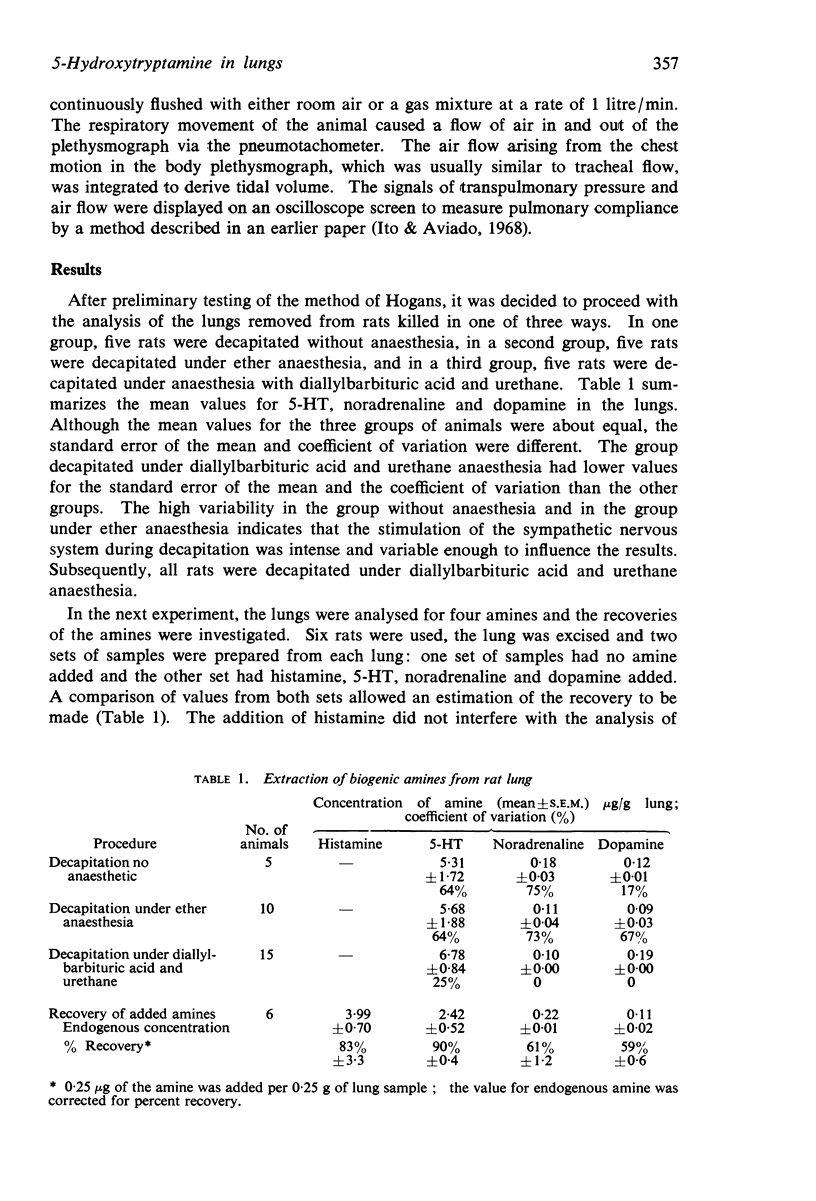
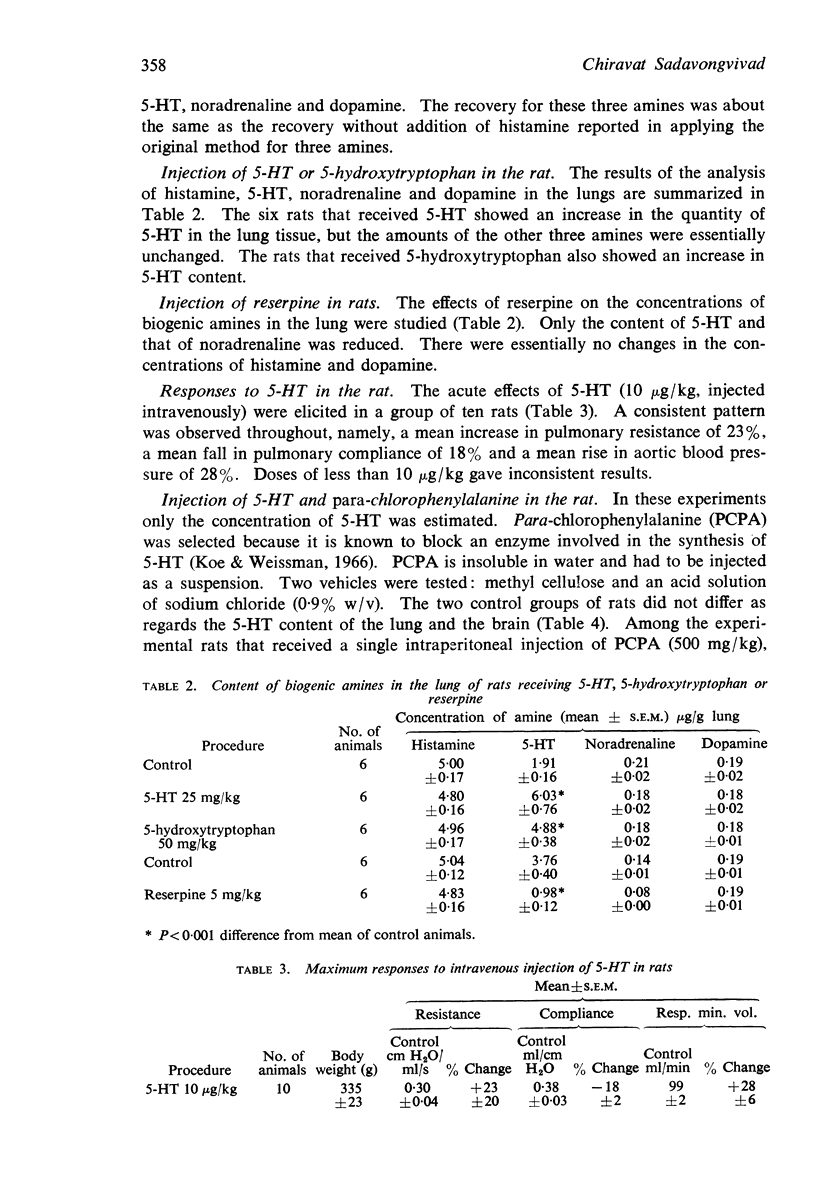
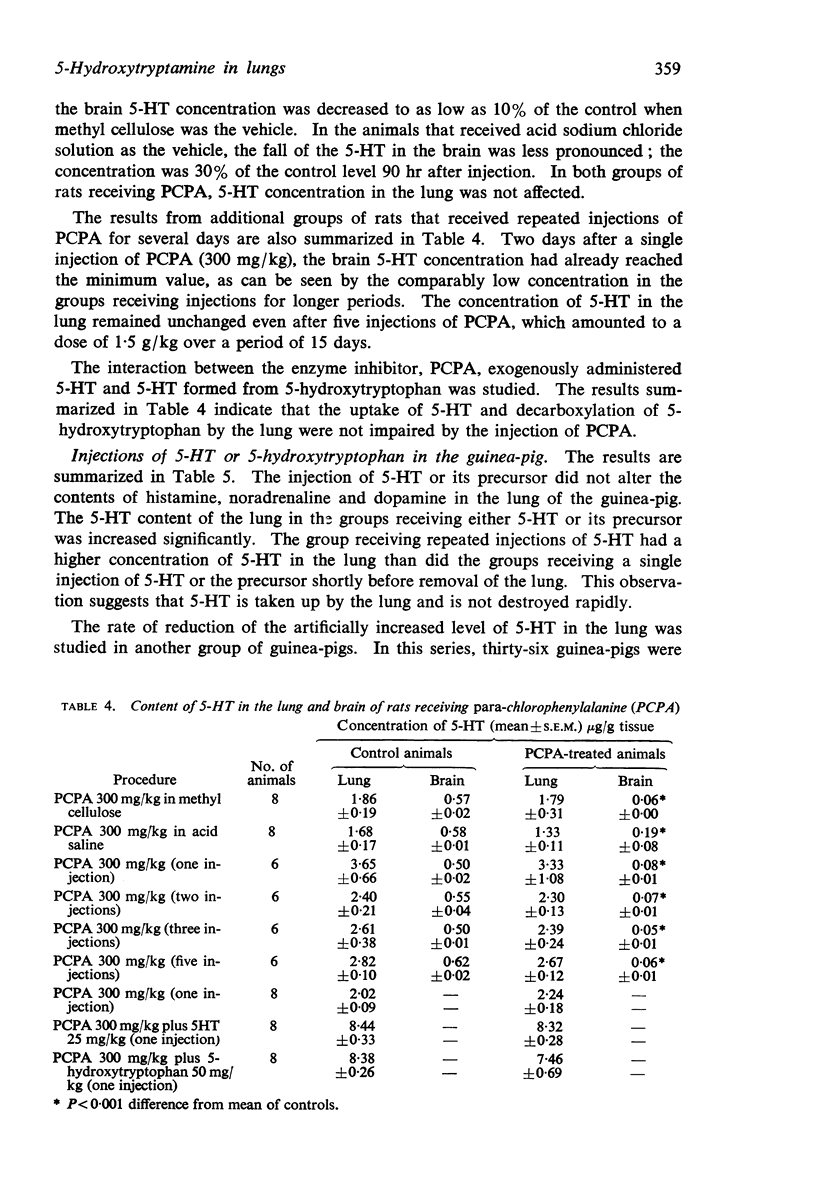
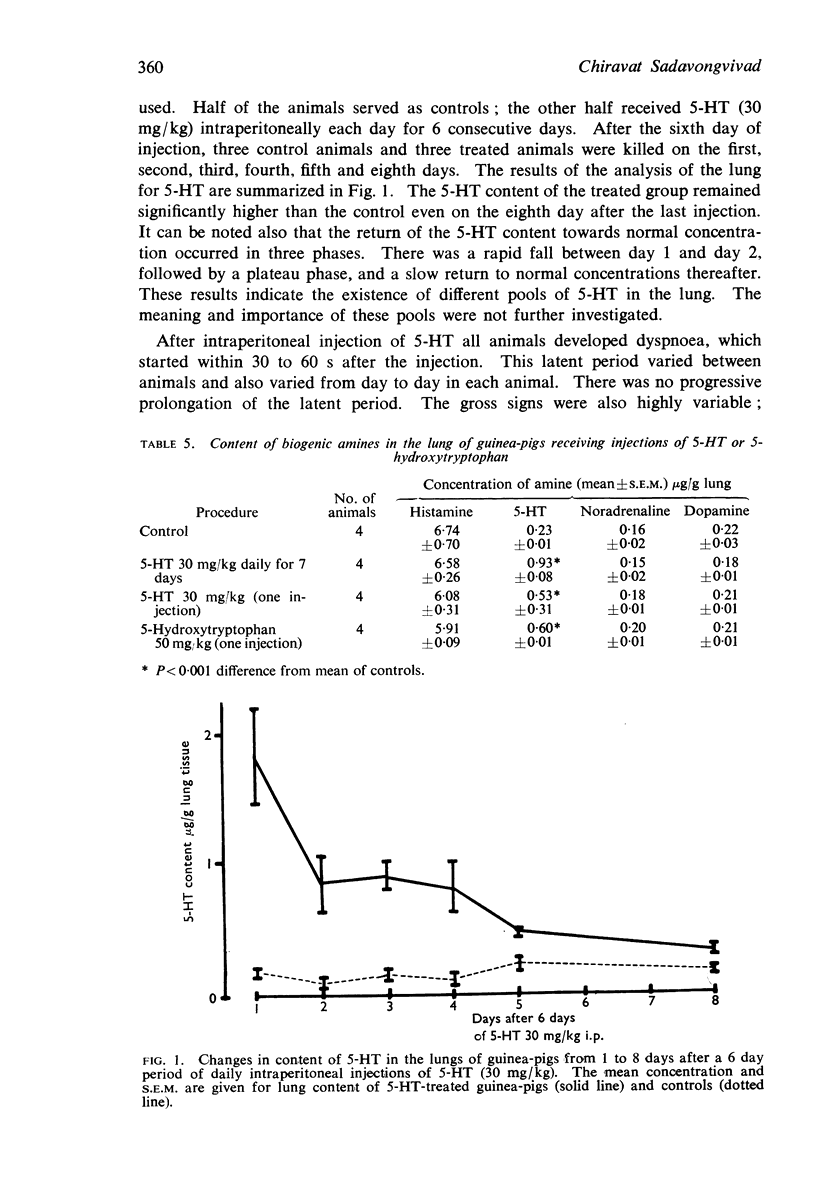
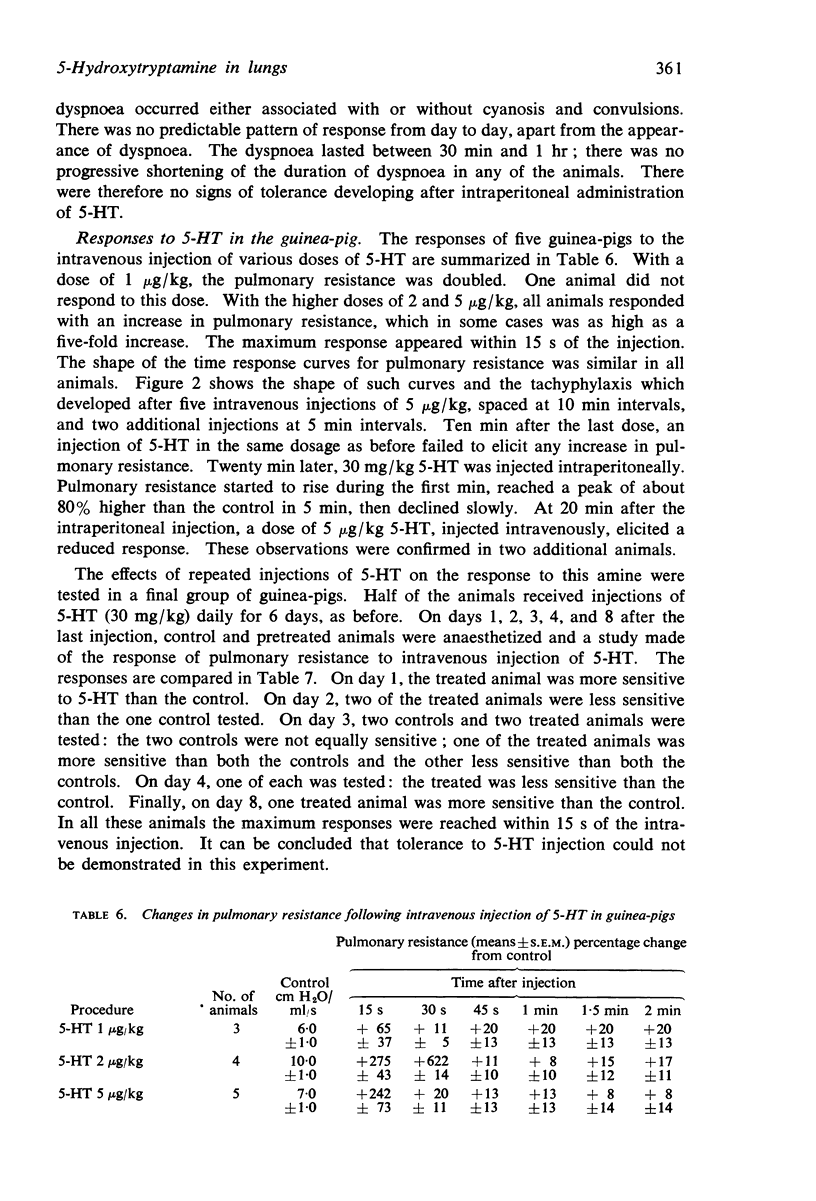
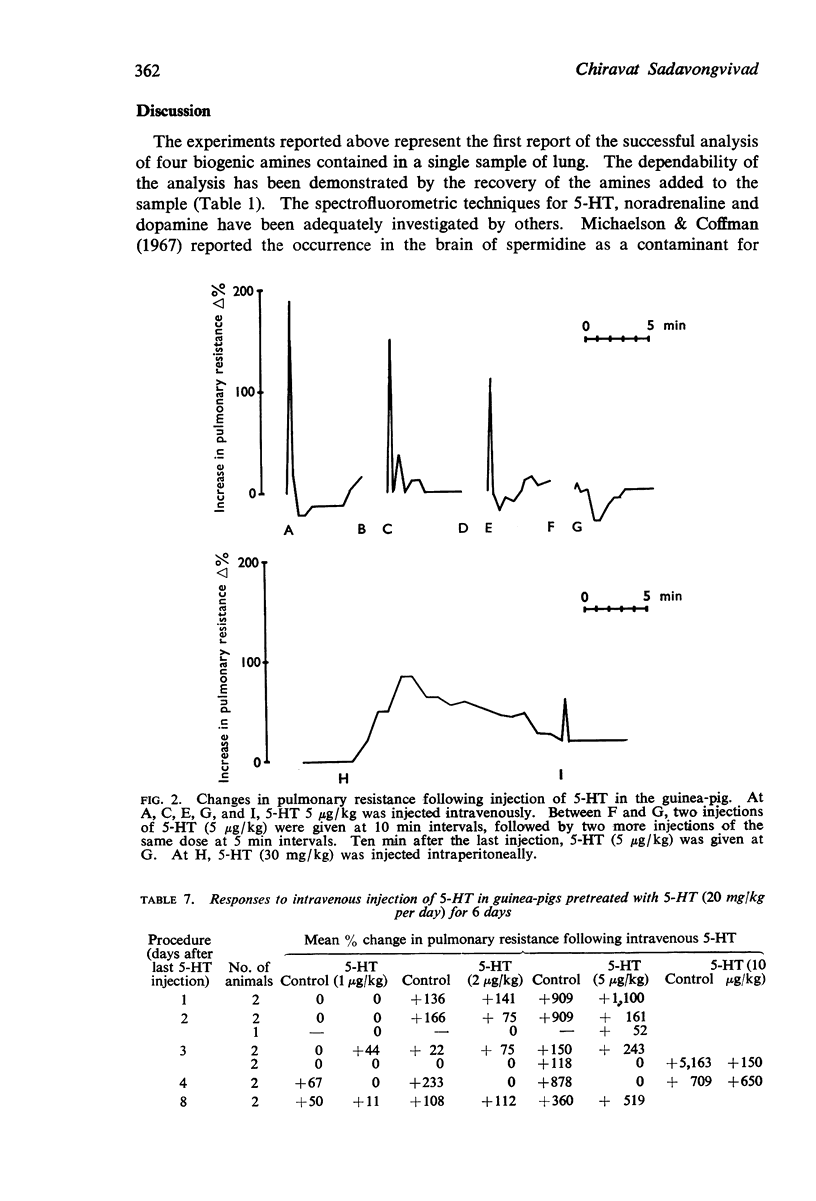
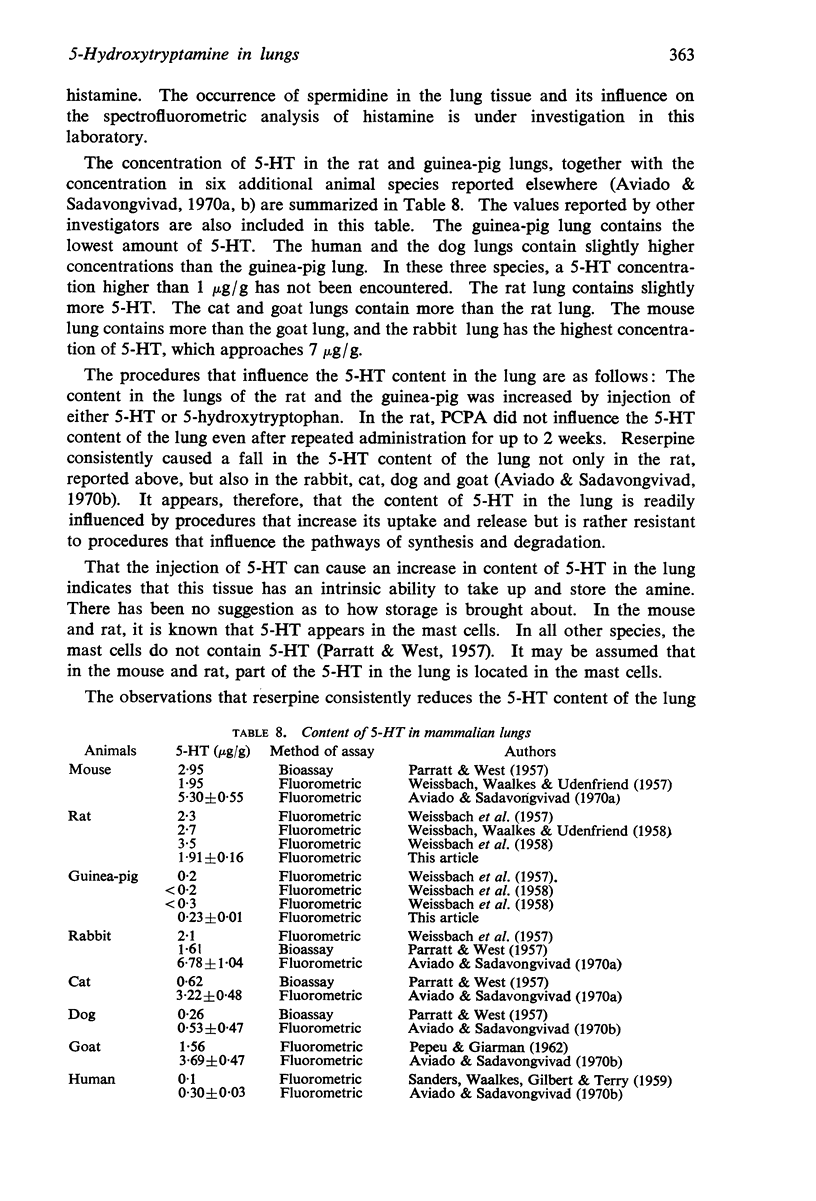
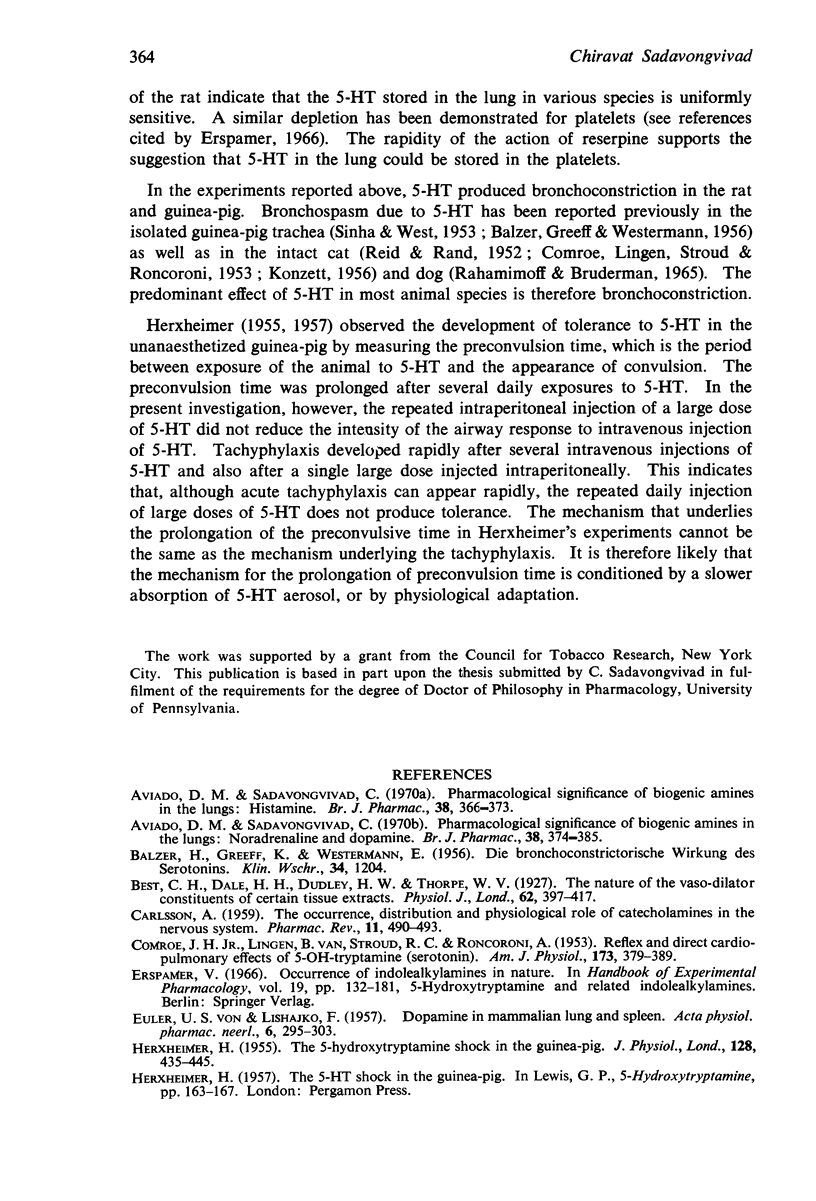
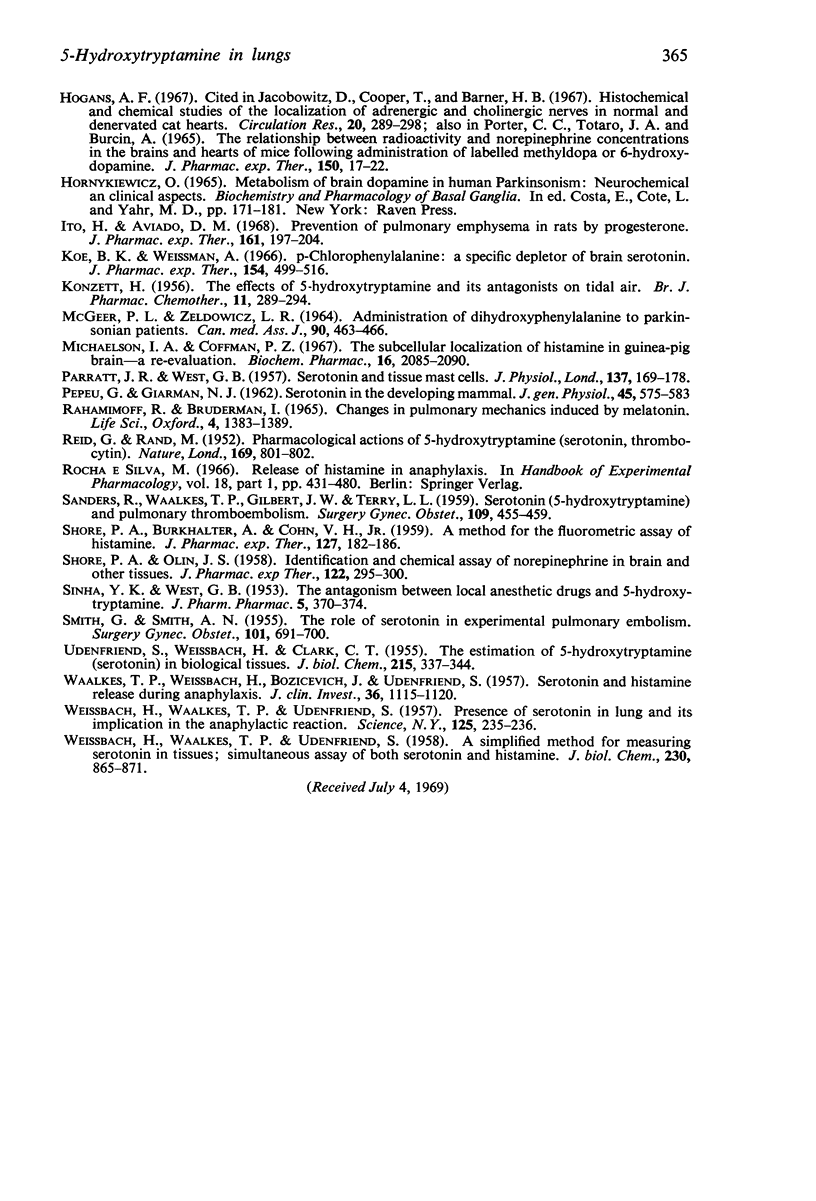
Selected References
These references are in PubMed. This may not be the complete list of references from this article.
- Aviado D. M., Sadavongvivad C. Pharmacological significance of biogenic amines in the lungs: histamine. Br J Pharmacol. 1970 Feb;38(2):366–373. doi: 10.1111/j.1476-5381.1970.tb08524.x. [DOI] [PMC free article] [PubMed] [Google Scholar]
- Aviado D. M., Sadavongvivad C. Pharmacological significance of biogenic amines in the lungs: noradrenaline and dopamine. Br J Pharmacol. 1970 Feb;38(2):374–385. doi: 10.1111/j.1476-5381.1970.tb08525.x. [DOI] [PMC free article] [PubMed] [Google Scholar]
- BALZER H., GREEFF K., WESTERMANN E. Die bronchoconstrictorische Wirkung des Serotonins. Klin Wochenschr. 1956 Nov 15;34(43-44):1204–1204. doi: 10.1007/BF01467858. [DOI] [PubMed] [Google Scholar]
- Best C. H., Dale H. H., Dudley H. W., Thorpe W. V. The nature of the vaso-dilator constituents of certain tissue extracts. J Physiol. 1927 Mar 15;62(4):397–417. doi: 10.1113/jphysiol.1927.sp002369. [DOI] [PMC free article] [PubMed] [Google Scholar]
- CARLSSON A. The occurrence, distribution and physiological role of catecholamines in the nervous system. Pharmacol Rev. 1959 Jun;11(2 Pt 2):490–493. [PubMed] [Google Scholar]
- COMROE J. H., Jr, VAN LINGEN B., STROUD R. C., RONCORONI A. Reflex and direct cardiopulmonary effects of 5-OH-tryptamine (serotonin); their possible role in pulmonary embolism and coronary thrombosis. Am J Physiol. 1953 Jun;173(3):379–386. doi: 10.1152/ajplegacy.1953.173.3.379. [DOI] [PubMed] [Google Scholar]
- HERXHEIMER H. The 5-hydroxytryptamine shock in the guinea-pig. J Physiol. 1955 Jun 28;128(3):435–445. doi: 10.1113/jphysiol.1955.sp005317. [DOI] [PMC free article] [PubMed] [Google Scholar]
- Ito H., Aviado D. M. Prevention of pulmonary emphysema in rats by progesterone. J Pharmacol Exp Ther. 1968 Jun;161(2):197–204. [PubMed] [Google Scholar]
- Jacobowitz D., Cooper T., Barner H. B. Histochemical and chemical studies of the localization of adrenergic and cholinergic nerves in normal and denervated cat hearts. Circ Res. 1967 Mar;20(3):289–298. doi: 10.1161/01.res.20.3.289. [DOI] [PubMed] [Google Scholar]
- KONZETT H. The effects of 5-hydroxytryptamine and its antagonists on tidal air. Br J Pharmacol Chemother. 1956 Sep;11(3):289–294. doi: 10.1111/j.1476-5381.1956.tb01068.x. [DOI] [PMC free article] [PubMed] [Google Scholar]
- Koe B. K., Weissman A. p-Chlorophenylalanine: a specific depletor of brain serotonin. J Pharmacol Exp Ther. 1966 Dec;154(3):499–516. [PubMed] [Google Scholar]
- MCGEER P. L., ZELDOWICZ L. R. ADMINISTRATION OF DIHYDROXYPHENYLALANINE TO PARKINSONIAN PATIENTS. Can Med Assoc J. 1964 Feb 15;90:463–466. [PMC free article] [PubMed] [Google Scholar]
- Michaelson I. A., Coffman P. Z. The subcellular localization of histamine in guinea pig brain--a re-evaluation. Biochem Pharmacol. 1967 Nov;16(11):2085–2090. doi: 10.1016/0006-2952(67)90004-4. [DOI] [PubMed] [Google Scholar]
- PARRATT J. R., WEST G. B. 5-Hydroxytryptamine and tissue mast cells. J Physiol. 1957 Jul 11;137(2):169–178. doi: 10.1113/jphysiol.1957.sp005804. [DOI] [PMC free article] [PubMed] [Google Scholar]
- PEPEU G., GIARMAN N. J. Serotonin in the developing mammal. J Gen Physiol. 1962 Jan;45:575–583. doi: 10.1085/jgp.45.3.575. [DOI] [PMC free article] [PubMed] [Google Scholar]
- Porter C. C., Totaro J. A., Burcin A. The relationship between radioactivity and norepinephrine concentrations in the brains and hearts of mice following administration of labeled methyldopa or 6-hydroxydopamine. J Pharmacol Exp Ther. 1965 Oct;150(1):17–22. [PubMed] [Google Scholar]
- REID G., RAND M. Pharmacological actions of synthetic 5-hydroxytryptamine (serotonin, thrombocytin). Nature. 1952 May 10;169(4306):801–802. doi: 10.1038/169801a0. [DOI] [PubMed] [Google Scholar]
- Rahamimoff R., Bruderman I. Changes in pulmonary mechanics induced by melatonin. Life Sci. 1965 Jul;4(14):1383–1389. doi: 10.1016/0024-3205(65)90016-0. [DOI] [PubMed] [Google Scholar]
- SANDERS R., WAALKES T. P., GILBERT J. W., Jr, TERRY L. L. Serotonin (5-hydroxytryptamine) and pulmonary thromboembolism. Surg Gynecol Obstet. 1959 Oct;109:455–459. [PubMed] [Google Scholar]
- SHORE P. A., BURKHALTER A., COHN V. H., Jr A method for the fluorometric assay of histamine in tissues. J Pharmacol Exp Ther. 1959 Nov;127:182–186. [PubMed] [Google Scholar]
- SHORE P. A., OLIN J. S. Identification and chemical assay of norepinephrine in brain and other tissues. J Pharmacol Exp Ther. 1958 Mar;122(3):295–300. [PubMed] [Google Scholar]
- SINHA Y. K., WEST G. B. The antagonism between local anaesthetic drugs and 5-hydroxytryptamine. J Pharm Pharmacol. 1953 Jun;5(6):370–374. doi: 10.1111/j.2042-7158.1953.tb13998.x. [DOI] [PubMed] [Google Scholar]
- UDENFRIEND S., WAALKES T. P., WEISSBACH H. Presence of serotonin in lung and its implication in the anaphylactic reaction. Science. 1957 Feb 8;125(3241):235–236. doi: 10.1126/science.125.3241.235-b. [DOI] [PubMed] [Google Scholar]
- UDENFRIEND S., WEISSBACH H., CLARK C. T. The estimation of 5-hydroxytryptamine (serotonin) in biological tissues. J Biol Chem. 1955 Jul;215(1):337–344. [PubMed] [Google Scholar]
- VON EULER U. S., LISHAJKO F. Dopamine in mammalian lung and spleen. Acta Physiol Pharmacol Neerl. 1957;6:295–303. [PubMed] [Google Scholar]
- WAALKES T. P., WEISSBACH H., BOZICEVICH J., UDENFRIEND S. Serotonin and histamine release during anaphylaxis in the rabbit. J Clin Invest. 1957 Jul;36(7):1115–1120. doi: 10.1172/JCI103507. [DOI] [PMC free article] [PubMed] [Google Scholar]
- WEISSBACH H., WAALKES T. P., UDENFRIEND S. A simplified method for measuring serotonin in tissues; simultaneous assay of both serotonin and histamine. J Biol Chem. 1958 Feb;230(2):865–871. [PubMed] [Google Scholar]


